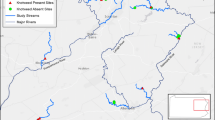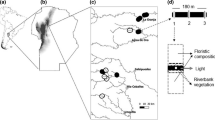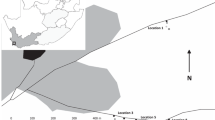Abstract
Habitat loss is causing amphibian population declines worldwide, so there is increased attention to forces that degrade remaining habitats. Terrestrial habitats surrounding wetlands are critical foraging areas for temperate anurans. We investigated plant community changes in two old fields invaded by Japanese knotweed (Fallopia japonica) and the foraging success of Green frogs (Rana clamitans) in invaded and non-invaded portions of those fields. Within each field, vegetation data were recorded in quadrats located along two transects bisecting the invasion fronts. We placed frogs in ‘foraging buckets’ along transects and measured their change in mass over a 38 h period. There were significant changes in vegetation structure and composition associated with Japanese knotweed invasion. Diverse assemblages of native plants that covered non-invaded plots were absent from areas invaded by Japanese knotweed. There was also a significant change in vegetation architecture between invaded and non-invaded habitats. Change in frog mass declined significantly along transects, with most frogs in non-invaded plots gaining mass and no frogs in invaded plots gaining mass. Most frogs from non-invaded plots but only two from invaded plots defecated shortly after removal from foraging buckets (verification of recent feeding). We hypothesize that Japanese knotweed invasions degrade terrestrial habitat quality for frogs by indirectly reducing arthropod abundance. Nonnative plant invasions may be another factor contributing to amphibian population declines.
Similar content being viewed by others
References
C. Adler (1993) ArticleTitleGowth and dispersal strategies and associations of the neophyte Polygonum Cuspidatum with special regard to showing Tuecenia 0 IssueID13 373–397
R.A. Alford S.J. Richards (1999) ArticleTitleGlobal amphibian declines: a problem in applied ecology Ann. Rev. Ecol. Syst. 30 133–165 Occurrence Handle10.1146/annurev.ecolsys.30.1.133
T.R. Angradi S.M. Hagan K.W. Able (2001) ArticleTitleVegetation type and the intertidal macroinvertebrate fauna of a brackish marsh: Phragmites vs Spartina Wetlands 21 75–92
B. Blossey (1999) ArticleTitleBefore during and after: the need for long-term monitoring in invasive species management Biol. Invasions 1 301–311 Occurrence Handle10.1023/A:1010084724526
L.W. Carr L. Fahrig (2001) ArticleTitleEffect of road traffic on two amphibian species of differing vagility Conserv. Biol. 15 1071–1078 Occurrence Handle10.1046/j.1523-1739.2001.0150041071.x
A.P. Conolly (1977) ArticleTitleThe distribution and history in the British Isles of some alien species of Polygonum and Reynoutria. Watsonia 11 291–311
P.G. deMaynadier M.L. Hunter SuffixJr. (2000) ArticleTitleRoad effects on amphibian movements in a forested landscape Nat. Areas J. 20 56–65
J.B. Dunning B.J. Danielson H.R. Pulliam (1992) ArticleTitleEcological processes that affect populations in complex landscapes Oikos 65 165–179
A.D. Guerry M.L. Hunter SuffixJr. (2002) ArticleTitleAmphibian distributions in a landscape of forests and agriculture: an examination of landscape composition and configuration Conserv. Biol. 16 745–754 Occurrence Handle10.1046/j.1523-1739.2002.00557.x
N.M. Haddad D. Tilman J. Haarstad M.E. Ritchie J.M.H. Knops (2001) ArticleTitleContrasting effects of plant richness and composition on insect communities: a field experiment Am. Naturalist 158 17–35 Occurrence Handle10.1086/320866
J.D. Hansen A.J. Castelle (1999) ArticleTitleInsect diversity in soils of tidal and non-tidal wetlands of Spencer Island Washington J. Kansas Entomol. Soc. 72 262–272
A.M. Herrera T.L. Dudley (2003) ArticleTitleReduction of riparian arthropod abundance and diversity as a consequence of giant reed (Arundo donax) invasion Biol. Invasions 5 167–177 Occurrence Handle10.1023/A:1026190115521
V.S. Lamoureux D.M. Madison (1999) ArticleTitleOverwintering habitats of radio-implanted green frogs, Rana clamitans J. Herpetol. 33 430–435
V.S. Lamoureux J.C. Maerz D.M. Madison (2002) ArticleTitlePre-migratory autumn foraging forays in the green frog, Rana clamitans J. Herpetol. 36 245–254
Locandro R.R. 1973. Reproduction ecology of Polygonum Cuspidatum. Ph.D. Dissertation. Rutgers University, New Brunswick, New Jersey, USA.
D.M. Madison (1997) ArticleTitleThe emigration of radio-implanted spotted salamanders, Ambystoma maculatum J. Herpetol. 31 542–551
S.E. Pope L. Fahrig H.G. Merriam (2000) ArticleTitleLandscape complementation and metapopulation effects on leopard frog populations Ecology 81 2498–2508
L.A. Seiger (1997) The status of Fallopia japonica (Reynoutria japonica; Polygonum cuspidatum) in North America J.H. Brock M. Wade P. Pysek D. Green (Eds) Plant Invasions: Studies from North American and Europe Backhuys Publishers Leiden, Netherlands 95–102
R.H. Shaw L.A. Seiger (2002) Japanese knotweed R. Van Driesche B. Blossey M. Hoddle S. Lyon R. Reardon (Eds) Biological Control of Invasive Plants in the Eastern United States USDA Forest Service Morgantown, West Virginia 159–166
Author information
Authors and Affiliations
Corresponding author
Rights and permissions
About this article
Cite this article
Maerz, J.C., Blossey, B. & Nuzzo, V. Green Frogs Show Reduced Foraging Success in Habitats Invaded by Japanese knotweed. Biodivers Conserv 14, 2901–2911 (2005). https://doi.org/10.1007/s10531-004-0223-0
Received:
Accepted:
Issue Date:
DOI: https://doi.org/10.1007/s10531-004-0223-0




